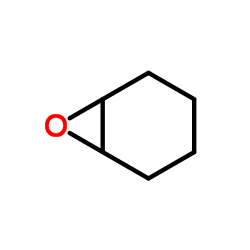Cyclohexene oxide

Cyclohexene oxide structure
|
Common Name | Cyclohexene oxide | ||
|---|---|---|---|---|
| CAS Number | 286-20-4 | Molecular Weight | 98.143 | |
| Density | 1.0±0.1 g/cm3 | Boiling Point | 130.3±8.0 °C at 760 mmHg | |
| Molecular Formula | C6H10O | Melting Point | -40 °C | |
| MSDS | Chinese USA | Flash Point | 27.2±0.0 °C | |
| Symbol |



GHS02, GHS05, GHS06 |
Signal Word | Danger | |
|
New systematically modified vesamicol analogs and their affinity and selectivity for the vesicular acetylcholine transporter - A critical examination of the lead structure.
Eur. J. Med. Chem. 100 , 50-67, (2015) To verify vesamicol as lead structure in the development of radioligands for imaging of VAChT in the brain by PET, we systematically modified this molecule and investigated four different groups of derivatives. Structural changes were conducted in all three r... |
|
|
A Mild Catalytic Oxidation System: FePcOTf/H2O2 Applied for Cyclohexene Dihydroxylation.
Molecules 20 , 8429-39, (2015) Iron (III) phthalocyanine complexes were employed for the first time as a mild and efficient Lewis acid catalyst in the selective oxidation of cyclohexene to cyclohexane-1,2-diol. It was found that the catalyst FePcOTf shown excellent conversion and moderate ... |
|
|
Oviductal microsomal epoxide hydrolase (EPHX1) reduces reactive oxygen species (ROS) level and enhances preimplantation mouse embryo development.
Biol. Reprod. 81(1) , 126-32, (2009) Somatic cell-embryo coculture enhances embryo development in vitro by producing embryotrophic factor(s) and/or removing harmful substances from the culture environment. Yet, the underlying molecular mechanisms on how somatic cells remove the toxicants from th... |
|
|
First success of catalytic epoxidation of olefins by an electron-rich iron(III) porphyrin complex and H2O2: imidazole effect on the activation of H2O2 by iron porphyrin complexes in aprotic solvent.
J. Inorg. Biochem. 80(3-4) , 219-25, (2000) An electron-rich iron(III) porphyrin complex (meso-tetramesitylporphinato)iron(III) chloride [Fe(TMP)Cl], was found to catalyze the epoxidation of olefins by aqueous 30% H2O2 when the reaction was carried out in the presence of 5-chloro-1-methylimidazole (5-C... |
|
|
involvement of microsomal epoxide hydrolase enzyme in ovotoxicity caused by 7,12-dimethylbenz[a]anthracene.
Toxicol. Sci. 96(2) , 327-34, (2007) Ovarian follicle disruption in mice caused by 7,12-dimethylbenz[a]anthracene (DMBA) is attributed to its bioactivation by CYP1B1 to a 3,4-epoxide which is then hydrolyzed to form a 3,4-diol by microsomal epoxide hydrolase (mEH). Further epoxidation by CYP1A1 ... |
|
|
Alternating copolymerization of epoxides and cyclic anhydrides: an improved route to aliphatic polyesters.
J. Am. Chem. Soc. 129(37) , 11330-1, (2007)
|
|
|
Copolymerization of cyclohexene oxide with CO2 by using intramolecular dinuclear zinc catalysts.
Chemistry 11(12) , 3668-78, (2005) The intramolecular dinuclear zinc complexes generated in situ from the reaction of multidentate semi-azacrown ether ligands with Et(2)Zn, followed by treatment with an alcohol additive, were found to promote the copolymerization of CO(2) and cyclohexene oxide... |
|
|
Evaluation of ovotoxicity induced by 7, 12-dimethylbenz[a]anthracene and its 3,4-diol metabolite utilizing a ratin vitroovarian culture system
Toxicol. Appl. Pharmacol. 234(3) , 361-9, (2009) The polycyclic aromatic hydrocarbon 7, 12-dimethylbenz[a]anthracene, (DMBA), targets and destroys all follicle types in rat and mouse ovaries. DMBA requires bioactivation to DMBA-3,4-diol-1,2-epoxide for ovotoxicity via formation of the intermediate, DMBA-3,4... |
|
|
Copolymerization of CO2 and cyclohexene oxide using a lysine-based (salen)Cr(III)Cl catalyst.
Dalton Trans. (27) , 5406-10, (2009) A new, natural lysine-based (salen)Cr(III)Cl ((lys-salen)Cr(III)Cl) complex was prepared and its catalytic activity for the copolymerization of CO(2) and cyclohexene oxide (CHO) was described in the presence of PPNCl (PPN(+) = bis(triphenylphosphoranylidene)a... |
|
|
Evaluation of the developmental toxicity of thalidomide using frog embryo teratogenesis assay-xenopus (FETAX): biotransformation and detoxification.
Teratog. Carcinog. Mutagen. 20(1) , 35-47, (2000) The developmental toxicity of thalidomide was evaluated using FETAX (Frog Embryo Teratogenesis Assay - Xenopus). Young X. Laevis embryos were exposed to this compound in each of two concentration-response experiments with and without differently induced exoge... |